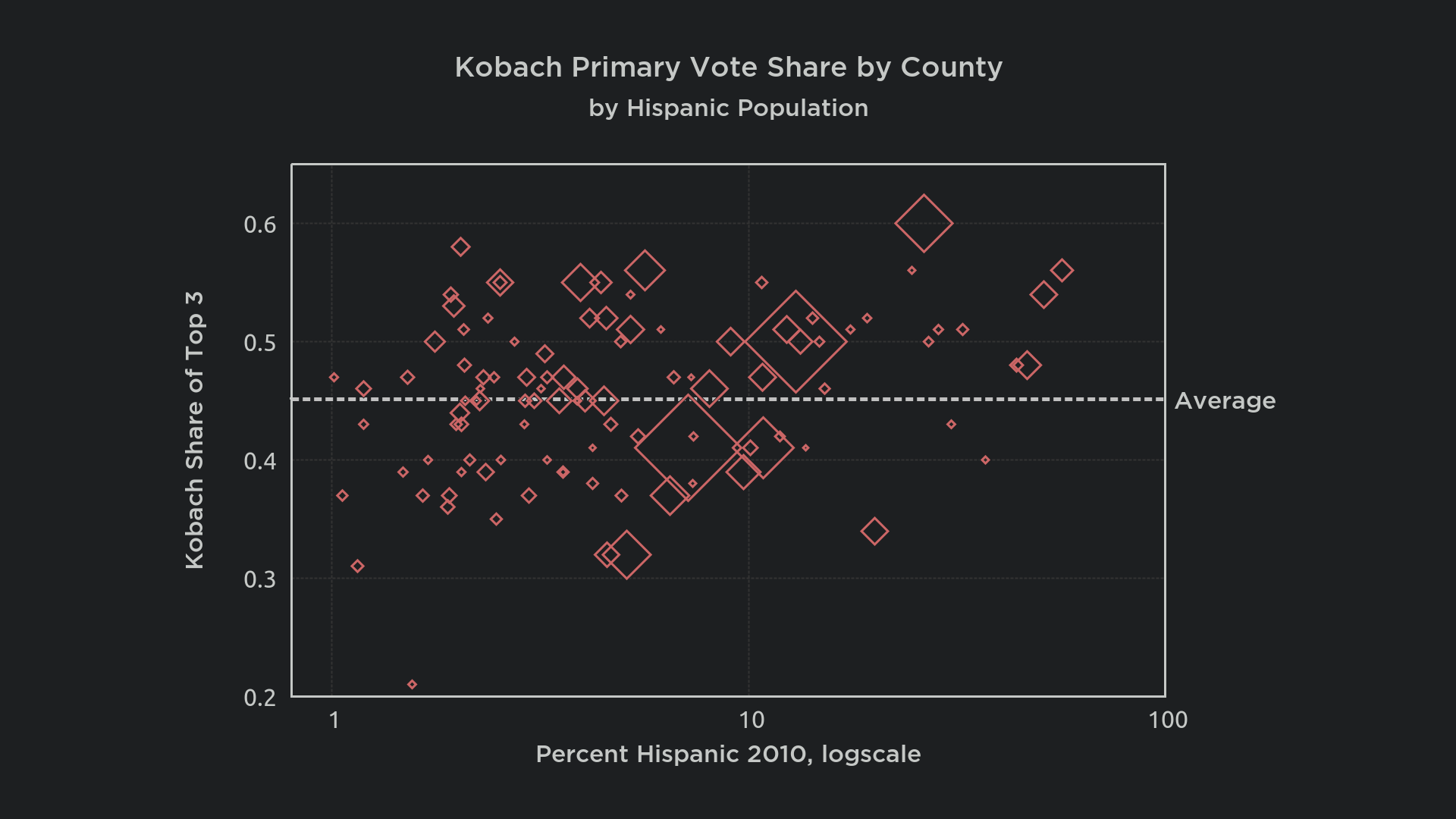Kobach Won the Browning Counties
2018-08-12
In a post yesterday Audacious Epigone describes anti-immigration incumbent Kris Kobach performing better in more hispanic counties:
On average, the counties that went to Kobach are 13.1% Hispanic. The counties Colyer won are 7.3% Hispanic.
The correlation by county between Kobach's share and the share of the population that is Hispanic is a positive .28. Fairly modest, but not insignificant.
I wanted to replicate this and look into it further, partly as an exercise in setting up my county-level database.
While A.E. used just the Kobach-Colyer vote share, I added Barnett as well, the last candidate for which the NYT interactive provided numbers. This changes almost nothing, so there is certainly little to gain from chasing down the remaining 10% of the vote.
Here is what the counties look like, with points scaled by population:

The upward trend is slight, but meaningful in the context of a competitive race.
The Correlation is Probably Even Stronger
A.E. claims a .28 correlation, which I think understates the relationship, as simple adjustments show. The distribution of hispanic population share is highly skewed, and logscale increases the strength slightly. Weighting the correlation by county population increases it even more. Doing both at once was not as dramatic.
Correlation of Kobach Vote to Hispanic Population| unadjusted | .281 |
| county population weighted | .385 |
| logscale hispanic share | .300 |
| logscale hispanic + population weighted | .316 |
I can't say which of these is the "correct" version, but A.E.'s .28 should be seen as a lower bound figure.
Hispanics Have Some Small Confounding Effect
As A.E. notes, the correlation of the white vote is understated due the offsetting effect of hispanics voting in the more hispanic counties, presumably for candidates other than Kobach. This is certainly the case, but there are forces acting against this bias:
- Hispanics are underrepresented as eligible voters relative to the population.
- Hispanics have lower voter turnout, even more so in off-year, state-level, and primary voting.
- Kansas has a mostly closed primary limiting influence of Democrat-leaning groups on Republican primaries.
How many hispanic votes are being cast in an off-year Republican primary in an 11% hispanic state? The answer, while greater than zero, is probably "not many".
I considered attempting an adjustment here, but none seemed possible without more information.
Change in Population is Even More Predictive
Immigration attitudes are sensitive to recent changes. Whites may be content with a ten percent hispanic area if they are confident they will remain a supermajority, but a town going from zero percent hispanic to ten percent in a short period of time sets off alarm bells.
With that in mind, here's what the results look like by change in hispanic population:

The raw corrlation is up slightly (.300), but population-weighted it's a striking .471, compared to .385 above. It's apparent the primary was competitive only in those counties with minimal hispanic growth.
The Present and Future of the Republican Party
Immigration will continue to dominate white politics in areas affected by it. Kansas is the latest instance of a recurring pattern, one uncomfortable to immigration proponents, but familiar to demographic realists. The proximate reaction is innately beneficial to Republicans; Awareness of demographics trends decreases white support for economically liberal programs, and increases anticipation of anti-white discrimination, among many similar effects. America's white majority intuitively, and correctly, understands that a less white country is worse for them, and without saying so explicitly, they are searching for candidates who will defend them from this threat.
White America deserves better defenders than Kris Kobach, whose time-consuming voter fraud efforts have been highly visible embarassments that failed to find any widespread criminality. The Republican Party needs to emerge as quickly as possible from its awkward transition phase of coded pro-white politics, and start running quality candidates to advance real issues for white Americans. The pressing fraud against our democracy is the one taking place legally, year by year, in hundreds of counties across America — and it's not going to be stopped by voter ID laws.
